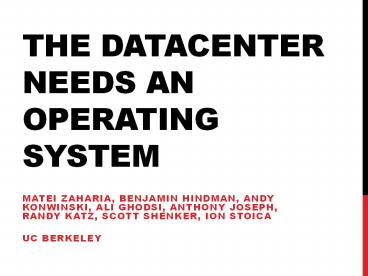The Datacenter Needs an Operating System - PowerPoint PPT Presentation
1 / 14
Title:
The Datacenter Needs an Operating System
Description:
The Datacenter Needs an Operating System Matei Zaharia, Benjamin Hindman, Andy Konwinski, Ali Ghodsi, Anthony Joseph, Randy Katz, Scott Shenker, Ion Stoica – PowerPoint PPT presentation
Number of Views:70
Avg rating:3.0/5.0
Title: The Datacenter Needs an Operating System
1
The Datacenter Needs an Operating System
- Matei Zaharia, Benjamin Hindman, Andy Konwinski,
Ali Ghodsi, Anthony Joseph, Randy Katz, Scott
Shenker, Ion Stoica
UC Berkeley
2
The Datacenter is the new Computer
- Running todays most popular consumer apps
- Facebook, Google, iCloud, etc
- Needed for big data in business science
- Widely accessible through cloud computing
Our claim this new computer needs an operating
system
3
Why Datacenters need an OS
- Growing diversity of applications
- Computing frameworks MapReduce, Dryad, Pregel,
Percolator, Dremel - Storage systems GFS, BigTable, Dynamo, etc
- Growing diversity of users
- 200 Hive users at Facebook
- Same reasons computersneeded one!
4
What Operating Systems Provide
Resource Sharing
time-sharing, virtual memory,
Programming Abstractions
Data Sharing
files, pipes, IPC,
libraries, languages
Debugging Monitoring
ptrace, DTrace, top,
5
What Operating Systems Provide
Resource Sharing
time-sharing, virtual memory,
Most importantly an ecosystem enabling
independently developedsoftware to interoperate
seamlessly
Programming Abstractions
Data Sharing
files, pipes, IPC,
libraries, languages
Debugging Monitoring
ptrace, DTrace, top,
6
Todays Datacenter OPERATING SYSTEM
- Platforms like Hadoop well-aware of these issues
- Inter-user resource sharing, but at the level of
MapReduce jobs (though this is changing) - InputFormat API for storage systems (but what
happens with the next hot platform after Hadoop?) - Other examples Amazon services, Google stack
7
Todays Datacenter OPERATING SYSTEM
- Platforms like Hadoop well-aware of these issues
- Inter-user resource sharing, but at the level of
MapReduce jobs (though this is changing) - InputFormat API for storage systems (but what
happens with the next hot platform after Hadoop?) - Other examples Amazon services, Google stack
The problems motivating a datacenter OS are well
recognized, but solutions are narrowly
targeted Can researchers take a longer-term view?
8
Tomorrows Datacenter OS
Resource Sharing
time-sharing, virtual memory,
Programming Abstractions
Data Sharing
files, pipes, IPC,
libraries, languages
Debugging Monitoring
ptrace, DTrace, top,
9
RESOURCE SHARING
To solve these interaction problems we would like
to have a computer made simultaneously available
to many users in a manner somewhat like a
telephone exchange. Each user would be able to
use a console at his own pace and without concern
for the activity of others using the system.
Fernando J. Corbató, 1962
10
Resource Sharing
- Today, cluster apps are built to run
independentlyand assume they own a fixed set of
nodes - Result inefficient static partitioning
- Whats the right interface for dynamic sharing?
App 1
App 2
App 3
11
Memory Management
- Memory is an increasingly important resource
- In-memory iterative processing (Pregel, Spark,
etc) - DFS cache for MapReduce cluster could serve 90
of jobs at Facebook (HotOS 11) - What are the right memory management algorithms
for a parallel analytics cluster?
12
Programmingand Debugging
- Although there are new programming models for
applications, system programming remains hard - Can we identify useful common abstractions?
(Chubby, Sinfonia, Mesos are some examples) - How much can languages (e.g. Go, Erlang) help?
- Debugging is very hard
- Magpie, X-Trace, Dapper are some steps here
- Can a clean-slate design of the stack help?
13
How Researchers can Help
- Focus on paradigms, not only performance
- Industry is spending a lot of time on performance
- Explore clean-slate approaches
- Much datacenter software is written from scratch
- People using Erlang, Scala, functional models
(MR) - Bring cluster computing to non-experts
- Most impactful (datacenter as the new
workstation) - Hard to make a Google-scale stack usable without
a Google-scale ops team
14
Conclusion
- Datacenters are becoming a major platform
- To support a thriving software ecosystem like
computers do, they need the equivalent of an OS - Researchers can take a long-term systems view to
problems arising today to enable this































